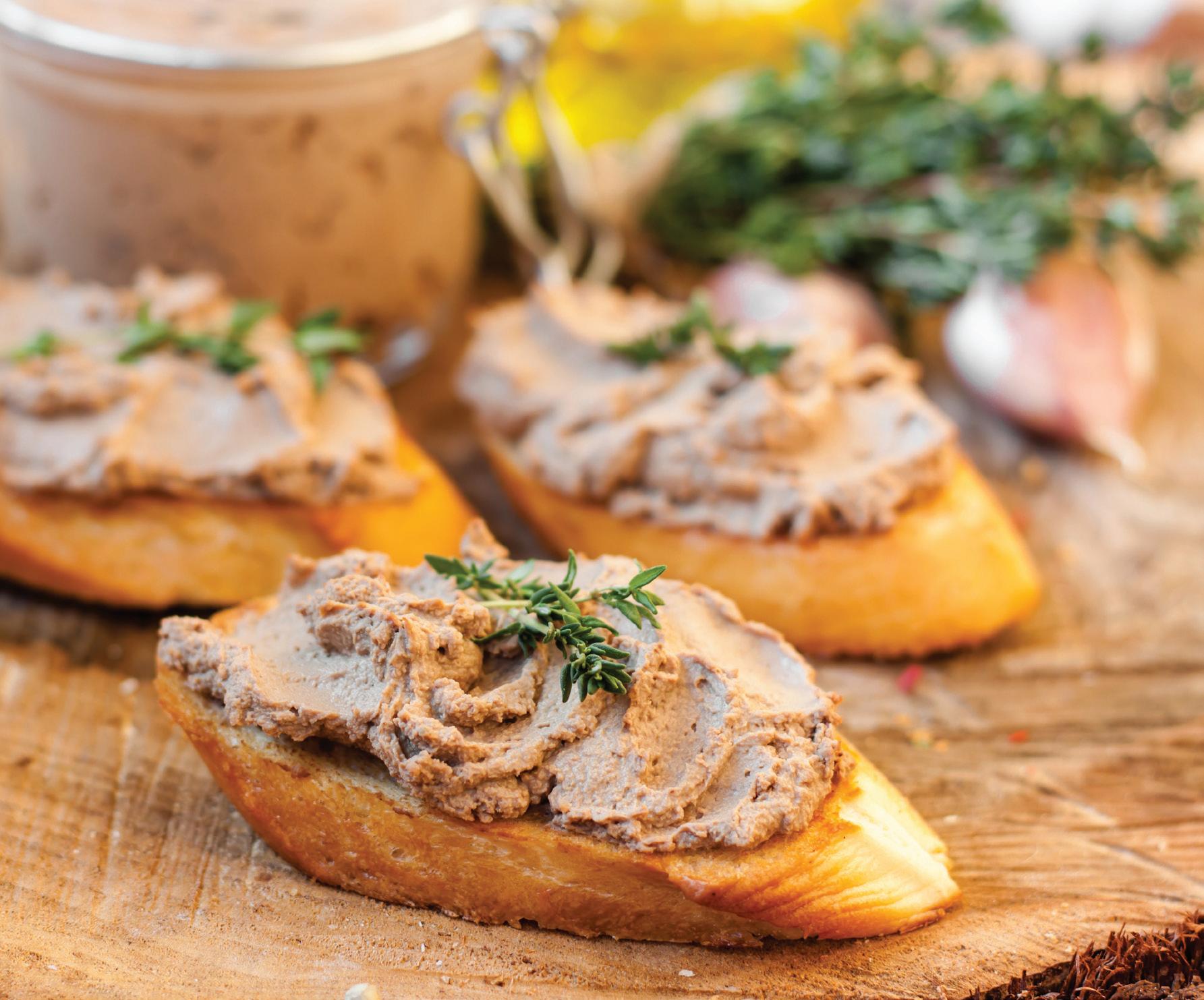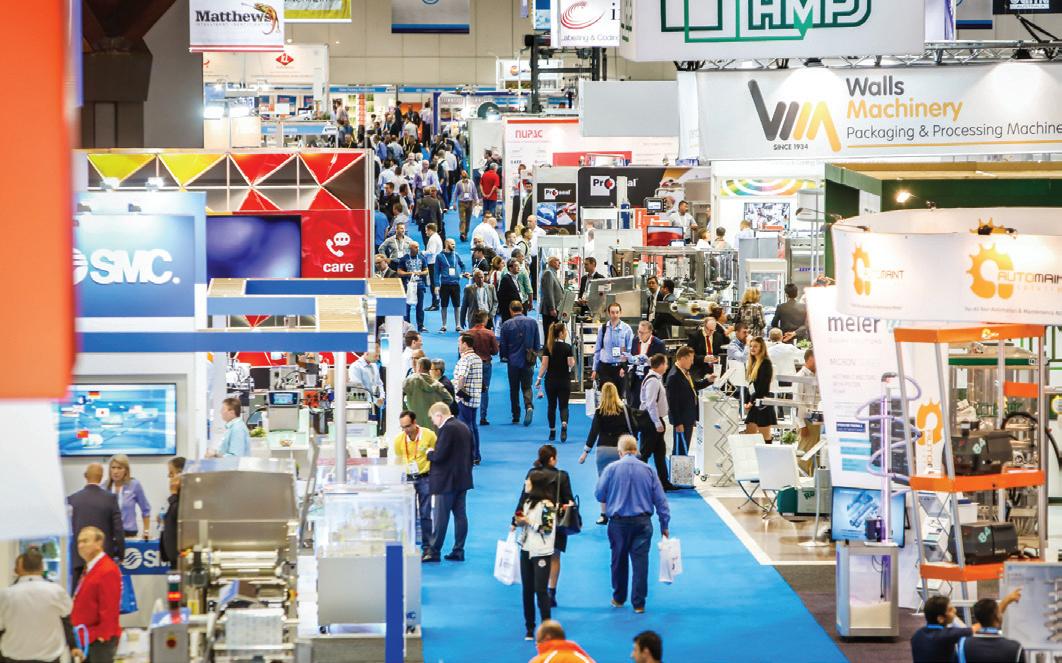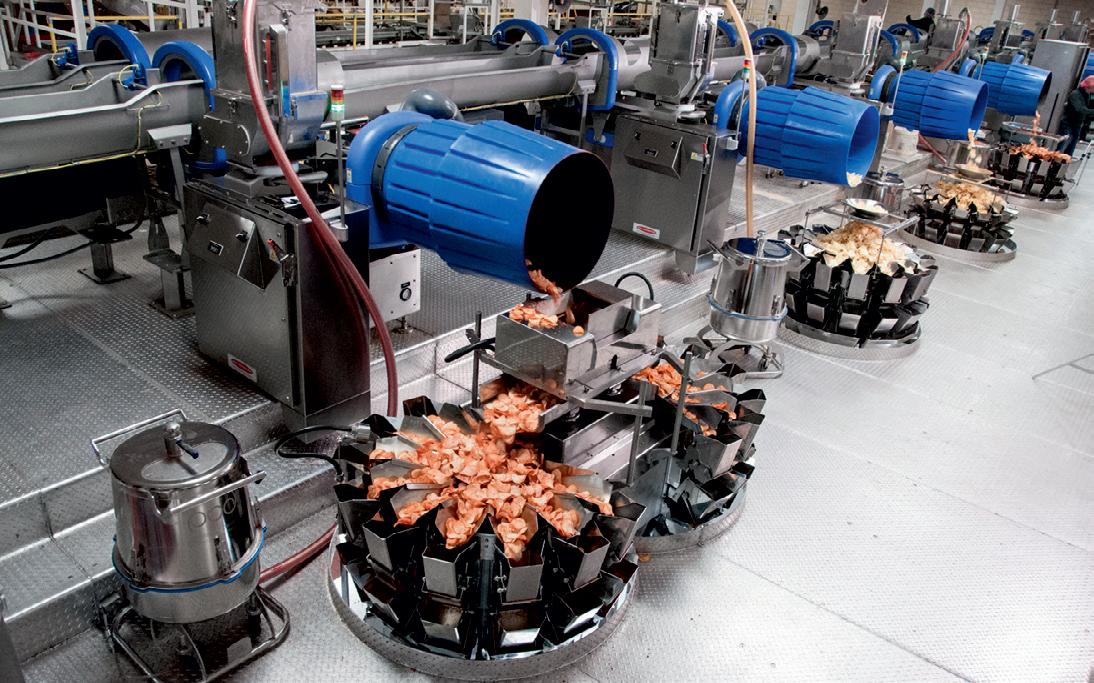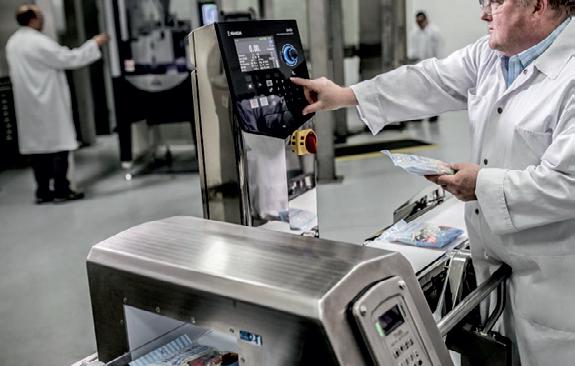
10 minute read
The science of delicious food
©stock.adobe.com/au/yuliiaholovchenko
Food texture has a crucial influence on the enjoyment of eating and acceptance of new food. It can make the difference between passing on a plate and love at first bite.
To date, most studies on food texture centre on relating a food’s overall composition to its mechanical properties. However, an understanding of how microscopic structure and changes in the shape of food affect food texture remains underdeveloped.
Researchers from Denmark and Germany conducted a series of experiments relating to food microstructure and rheology. The study published in Physics of Fluids by AIP Publishing looked at two dishes — foie gras and pâté — and showed how soft solids and some liquids deform to create texture. They used coherent anti-Stokes Raman scattering (CARS) microscopy to relate the molecular makeup of the fat in foods with the rheological and mechanical properties of the food.
“Using soft matter physics tools and models, we connected structural information in the food across length scales,” said author Thomas Vilgis. “We joined microscopy and rheology to understand the mouthfeel of food from a gastrophysical standpoint.”
Both deriving from duck livers, the two dishes are similar enough in overall structure, and their differing fat distribution provided a window into how fat affects texture.
“There are further different interesting aspects that can be targeted to create new products with the same features as these products,” said author Mathias P Clausen. The researchers wanted to determine if they could create foie gras-like textures using other ingredients, such as non-animal based, and also whether or not they could create Microscopic structure of fat (red) melting and creamy texture explains texture differences between from different fat sources. foie gras (left) and pâté (right). They used CARS microscopy to vibrate chemiImage credit: Matias A. Via and Mathias P. Clausen cal bonds in foods to tunable frequencies and cause them to emit light. The technique has been used for decades in other fields but, so far, has received relatively little use in food science.
The fat in foie gras had arranged into an irregularly shaped, weakly linked fat network embedded in a protein matrix, which made its mouthfeel harder, more brittle and more elastic than pâté’s.
The greater number of rounder and smoother fat particles and lack of an interconnected network were responsible for the pâté’s softer texture.
Clausen hopes their research stokes further interest in investigating which microscopic features of foods can be tweaked. The group looks to study other components of foods with advanced microscopy, such as protein arrangement, and see if they can use their findings to create foods that mimic the texture of foie gras.


image©iStockphoto.com
Fo d

FOR thought
©stock.adobe.com/au/Milan
FSANZ releases sugar labelling review
Food Standards Australia New Zealand (FSANZ) is beginning work on amending the Australia New Zealand Food Standards Code (the Food Standards Code) regarding the labelling of added sugars on nutritional information panels.
This follows the release of findings last year in its Review of nutrition labelling for added sugars. The review was undertaken at the request of food ministers with the aim of ensuring food labels provide adequate contextual information about sugars to enable consumers to make informed choices in support of dietary guidelines.
Quantifying added sugars in the nutrition information panel (NIP) was the option preferred by ministers. The review argued that while the process of labelling foods based on their added sugars would be complex, there were no technical reasons to not include these sugars on the NIP.
©stock.adobe.com/au/N_studio
SPC completes growth capital round of funding

SPC has announced that it has completed the growth capital round of funding, which has resulted in the injection of $111 million ready for the next phase of growth.
The capital comes from investments from the Australian Meat Industry Superannuation Trust (AMIST); the family office of Mr Khalil (Charlie) Shahin AO, Managing Director of Peregrine Corporation; and through the sale and leaseback of the flagship SPC property in Shepparton to Charter Hall.
As part of the investments, Murray Rutherford and Charlie Shahin of AMIST and Peregrine Corporation respectively become members of the SPC board.
“We are delighted with the new partnerships and look forward to working with our new Board, and welcome the knowledge and experience they bring,” said Robert Giles, CEO of SPC.
“SPC is committed to reinvesting in Australian products. In line with our vision for continued growth, we are doing all we can to highlight Australian food and beverages internationally. Local partnerships like these make our mission possible.
“SPC has an aggressive expansion plan that includes launching new products in existing and new categories, as well as acquisition plans in Australia and overseas. We are already in talks with a few parties, and expect to complete a key acquisition during 2022.”
Yili Group building ice-cream factory in Indonesia
Yili Group has launched the first phase of its Yili Indonesia Dairy Production Base, which will form a dual operation centre for Indonesia and Thailand.
Upon completion of the second phase, the company’s first self-built factory is set to become the country’s largest ice-cream factory with a daily production capacity of four million ice-cream products.
The facility has adopted cutting-edge technology and equipment, including the Internet of Things and big data analytics, to build an innovative and smart factory. The production base integrates advanced digital technologies throughout its entire production chain. Robotics solutions are introduced to provide automated packing, palletising and warehousing.
The construction of infrastructure and buildings has been undertaken strictly in line with Yili Group’s global quality management standards. To date, the factory has already passed the ISO22000, HALAL and BPOM certifications and been rated A grade by the LPPOM MUI food and drug certification agency in Indonesia.
As part of its efforts to build a sustainable and environmentally friendly production facility, Yili Indonesia Dairy has built a wastewater treatment system with a daily treatment capacity of 2800 tons. Reclaimed water is then used for the irrigation of plants in the factory.

Air Compressors: the high cost of not going green in your food and beverage production.
“You snooze, you lose.” Failing to seize an opportunity will result in disadvantages later and this applies nowhere more than in business. Going green is no exception.

One-hundred years ago, if you were still relying on horses and carts to move goods while your competitors used trucks, your company probably wasn’t going to last.
Twenty years ago, if you felt that the internet was a fad that would pass, then your market share probably ended up plummeting.
Today, that opportunity is Green technology and missing out on it will mean getting left behind.
While it is true that the initial investment for some eco-friendly equipment may be higher, a reduction in production costs in the long run and other benefits will quickly recover that difference and more.
That is why the real question companies should be asking, is not “What is it costing my company to go green?” but rather “What is it costing my company not going green?”
The answer is “a lot.”
There is something admirable about trying to squeeze every bit of performance out of an ageing machine. That in itself is a form of sustainability and resource preservation. However, in the case of air compressors, this is often neither efficient nor environmentallyfriendly. With Atlas Copco’s cutting edge variable speed drive technology that reduces energy use and energy costs by up to 60 percent, not upgrading to a new compressor is often much more wasteful than sticking with an old model.
Wouldn’t it be great if there was a way to make compressed air systems more efficient while saving money and the environment at the same time?
The bad news is that there isn’t one way to do that. The great news is that there are 10 ways!
Best of all, some of them involve things you can do today and that will cost you hardly anything at all. By the end of the day, you could already be saving money.
If you want to know how, check out our new “10-step guide to a greener, better, and more efficient production.” Scan the QR code now!
image©iStockphoto.com
Fo d

FOR thought
Registration to AUSPACK 2022 now open!

The AUSPACK 2022 processing and packaging trade event, which is part of Packaging and Processing Week, is being held at the Melbourne Convention and Exhibition Centre on 17–20 May 2022.
Mark Dingley, Chairman of the Australian Packaging & Processing Machinery Association (APPMA), which owns AUSPACK, said: “AUSPACK 2022 will showcase a host of global mega trends in the food, beverage and pharmaceutical processing and packaging industries.”
This year, more than 250 suppliers representing hundreds of global brands will be on the show floor, offering visitors solutions that address a range of industry trends and themes. The event will allow attendees to see, firsthand, products that offer enhanced safety, security, automation and cost-saving benefits.
The AUSPACK Leaders Forum, from 18–19 May, will offer business owners the opportunity to benchmark as an organisation of the future, gain knowledge and inspiration, and network with like-minded, forward-thinking leaders. Key themes include: • Future supply chain • Adapting and diversifying for commercial success • Future technology • Sustainability and the circular economy • Investment and collaboration • Future workforce
The expanded Solutions Theatres will give visitors in-depth overviews of technology, solutions and strategies, with sessions covering: • supply chain and procurement • education • preventive maintenance • materials and packaging design • network security • the circular economy • the future of manufacturing and warehousing • … and more.
The exhibition floor will also feature an array of new zones: IT & Services, Processing Equipment, Packaging and Packaging Materials, and Packaging Machinery, making navigation easier.
Behind-the-scenes enhancements to the exhibitors’ directory will allow visitors to search for very specific areas, while the highly searchable Leaders Forum will allow visitors to find topics that suit their interests.
• AUSPACK 2022 will be held at the Melbourne Convention and Exhibition Centre, 17–20 May 2022. • Tickets to the exhibition are free and are now available on the website. • For more information, visit www.auspack.com.au.
Kellogg ANZ appoints new MD
Kellogg ANZ has announced the appointment of experienced Kellogg Executive and FMCG industry leader Anthony Holme as its Managing Director. Holme has worked at Kellogg since 2017 and will be relocating from South Africa (where he has served as Kellogg South Africa General Manager since 2019) to Sydney for his new role. Prior to Kellogg, he has previously held senior leadership roles across sales and business development with Woolworths, PepsiCo, Diageo and SABMiller in both South Africa and the United Kingdom. Shumit Kapoor, President Kellogg AMEA, said, “We are pleased to appoint Anthony Holme to lead the Kellogg ANZ business. We believe that his experience will help build on our sustainable growth momentum in ANZ, develop our talent and bring more food innovation to our consumers.” Holme said, “I feel very privileged to have the opportunity to lead Kellogg’s ANZ business with its portfolio of iconic brands and an extremely talented team. I look forward to continuing to deliver great tasting foods that nourish Aussie and New Zealand consumers, whilst also finding new and innovative ways to reduce our impact on the environment and help protect our planet.”




















